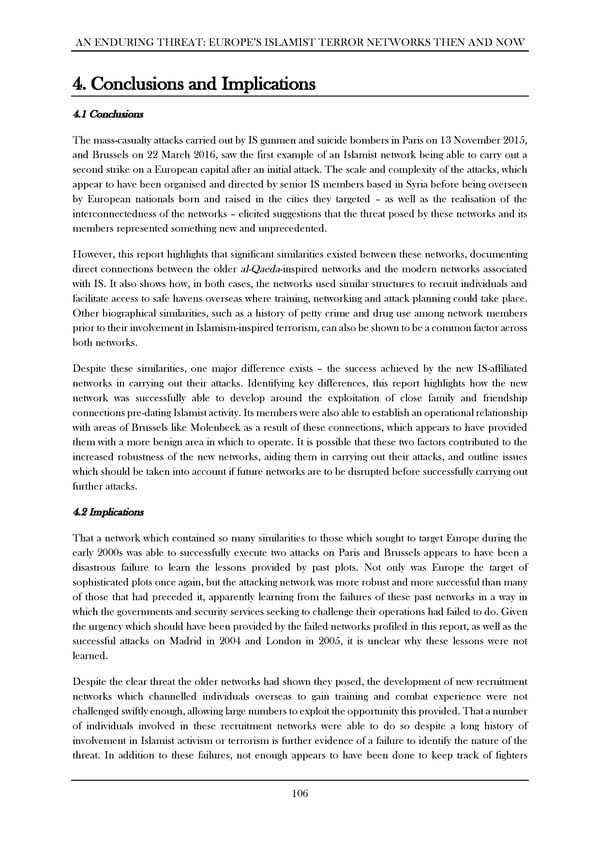AN ENDURING THREAT: EUROPE’S ISLAMIST TERROR NETWORKS THEN AND NOW 4. Conclusions and Implications ! 4.1 Conclusions The mass-casualty attacks carried out by IS gunmen and suicide bombers in Paris on 13 November 2015, and Brussels on 22 March 2016, saw the first example of an Islamist network being able to carry out a second strike on a European capital after an initial attack. The scale and complexity of the attacks, which appear to have been organised and directed by senior IS members based in Syria before being overseen by European nationals born and raised in the cities they targeted – as well as the realisation of the interconnectedness of the networks – elicited suggestions that the threat posed by these networks and its members represented something new and unprecedented. However, this report highlights that significant similarities existed between these networks, documenting direct connections between the older al-Qaeda-inspired networks and the modern networks associated with IS. It also shows how, in both cases, the networks used similar structures to recruit individuals and facilitate access to safe havens overseas where training, networking and attack planning could take place. Other biographical similarities, such as a history of petty crime and drug use among network members prior to their involvement in Islamism-inspired terrorism, can also be shown to be a common factor across both networks. Despite these similarities, one major difference exists – the success achieved by the new IS-affiliated networks in carrying out their attacks. Identifying key differences, this report highlights how the new network was successfully able to develop around the exploitation of close family and friendship connections pre-dating Islamist activity. Its members were also able to establish an operational relationship with areas of Brussels like Molenbeek as a result of these connections, which appears to have provided them with a more benign area in which to operate. It is possible that these two factors contributed to the increased robustness of the new networks, aiding them in carrying out their attacks, and outline issues which should be taken into account if future networks are to be disrupted before successfully carrying out further attacks. 4.2 Implications That a network which contained so many similarities to those which sought to target Europe during the early 2000s was able to successfully execute two attacks on Paris and Brussels appears to have been a disastrous failure to learn the lessons provided by past plots. Not only was Europe the target of sophisticated plots once again, but the attacking network was more robust and more successful than many of those that had preceded it, apparently learning from the failures of these past networks in a way in which the governments and security services seeking to challenge their operations had failed to do. Given the urgency which should have been provided by the failed networks profiled in this report, as well as the successful attacks on Madrid in 2004 and London in 2005, it is unclear why these lessons were not learned. Despite the clear threat the older networks had shown they posed, the development of new recruitment networks which channelled individuals overseas to gain training and combat experience were not challenged swiftly enough, allowing large numbers to exploit the opportunity this provided. That a number of individuals involved in these recruitment networks were able to do so despite a long history of involvement in Islamist activism or terrorism is further evidence of a failure to identify the nature of the threat. In addition to these failures, not enough appears to have been done to keep track of fighters ! ! 106 !
 An Enduring Threat: Europe’s Islamist Terror Networks Then and Now Page 111 Page 113
An Enduring Threat: Europe’s Islamist Terror Networks Then and Now Page 111 Page 113